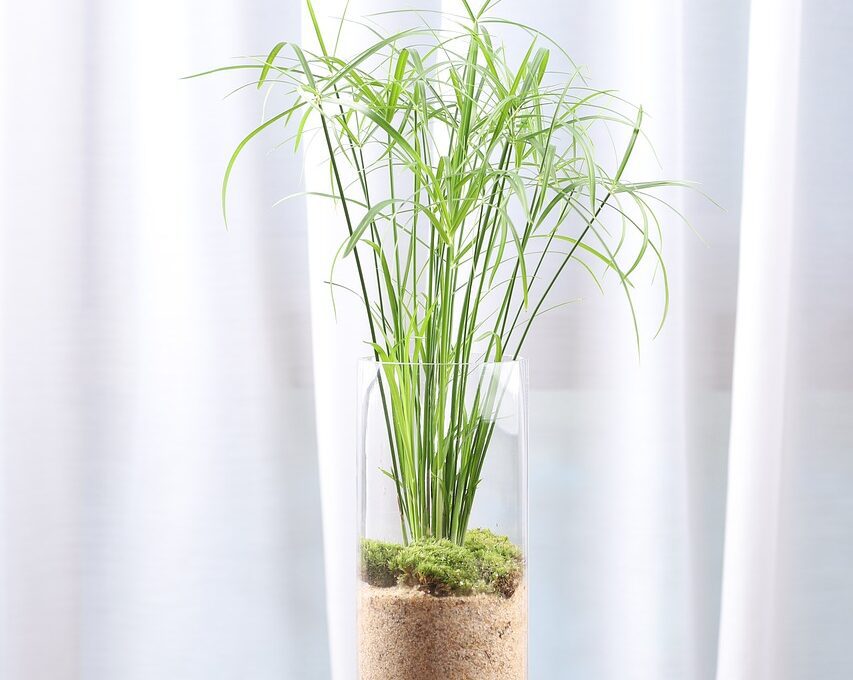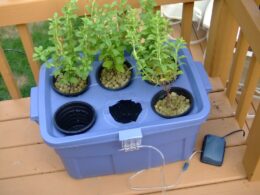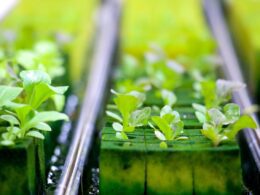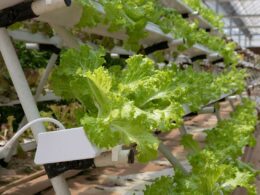Are you considering using LED lights for your hydroponic garden? LED lights have become increasingly popular in recent years due to their energy efficiency and long lifespan. But the question remains, do LED lights actually work for hydroponics?
In this article, we will explore the science behind LED lights, the benefits and drawbacks of using them for hydroponics, and provide tips for maximizing their effectiveness in your garden.
LED stands for ‘light emitting diode,’ and these lights work by passing an electrical current through a semiconductor material, which then emits light. Compared to traditional light sources like incandescent bulbs or fluorescent tubes, LED lights are much more efficient, producing more light per watt of energy consumed. This means that LED lights can save you money on your energy bill while still providing ample light for your plants to grow.
However, the effectiveness of LED lights for hydroponics depends on a variety of factors, including the type of plants you are growing, the size of your garden, and the specific LED lights you choose to use.
The Science Behind LED Lights
You’ll be amazed at how the science behind these energy-efficient bulbs can revolutionize your hydroponic setup. LED lights emit light in a specific range of wavelengths, also known as the LED light spectrum.
This range of light is tailored to meet the specific needs of plants, making them an excellent choice for indoor gardening. The photosynthesis mechanism within plants requires light to produce energy.
The effects of LED light color on plant growth are significant. Red and blue LED lights have been found to be the most effective for photosynthesis. These colors are absorbed by chlorophyll, the pigment that gives plants their green color, and are essential for plant growth.
When using LED lights for hydroponics, it’s important to choose the right color temperature for the specific plant you’re growing. Different plants have different light requirements, and using the wrong color temperature can negatively impact growth.
LED lights are an affordable and environmentally friendly way to provide optimal lighting for your hydroponic setup.
Benefits of Using LED Lights for Hydroponics
Switching to LED lighting can give your hydroponic garden a boost of energy, leading to healthier and more vibrant plants.
One of the biggest benefits of LED lights is their energy efficiency. They use significantly less electricity than traditional lighting, which can save you money on your energy bill while also reducing your carbon footprint.
LED lights also provide a specific spectrum of light that’s optimized for plant growth. This means that your plants will receive the exact amount of light they need, without any wasted energy or excess heat. Plus, LED lights produce very little heat compared to traditional lighting, which can be beneficial in preventing excess heat buildup in your hydroponic system.
Overall, using LED lights for hydroponics can provide a range of benefits for both your plants and your wallet. With their energy efficiency and optimized spectrum of light, you can expect to see healthier and more vibrant plants in your hydroponic garden. So why not make the switch to LED lighting and give your plants the boost they need?
Drawbacks of Using LED Lights for Hydroponics
If you’re looking for the perfect lighting solution for your hydroponic garden and want to avoid potential drawbacks, it’s important to consider the limitations of using LED technology. While LED lights offer many benefits, they also come with some disadvantages and challenges that you should be aware of before making a purchase.
-
Limited coverage area: LED lights have a narrow beam angle which means they cover a smaller area compared to other types of grow lights. This can be a challenge if you have a large hydroponic setup and need to cover a larger area.
-
High upfront cost: LED lights can be expensive to purchase upfront, especially if you opt for high-quality models. This can be a drawback for individuals who are looking to start a hydroponic garden on a budget.
-
Heat management: LED lights produce less heat compared to other types of grow lights, but they still produce some heat. If you have a small indoor space, this can be a challenge as it can lead to increased temperatures which can harm your plants.
-
Limited spectrum: While LED lights offer a wide range of spectrum options, they still have limitations compared to other types of grow lights. This can be a challenge if you’re looking for a specific spectrum to support the growth of your plants.
In summary, while LED lights offer many benefits for hydroponic gardening, they also come with some limitations and challenges. It’s important to carefully consider your needs and budget before making a purchase to ensure that LED lights are the right choice for your hydroponic setup. By understanding the disadvantages of LED lights, you can make an informed decision and create a successful hydroponic garden.
Choosing the Right LED Lights for Your Hydroponic Garden
When choosing LED lights for your hydroponic garden, consider your plant’s needs first and foremost. Look for high-quality brands that offer the right spectrum of light for optimal plant growth. Pay attention to wattage and coverage area to ensure that your plants receive enough light to thrive.
Don’t settle for subpar lighting – investing in the right LED lights can make all the difference in your hydroponic garden’s success.
Consider Your Plant’s Needs
Think about what your plants need in terms of light and adjust accordingly to give them the best chance for success. Different plants have different light requirements, so it’s important to choose LED lights that provide the right spectrum and intensity for your specific plants.
For example, plants that produce fruit or flowers require more red and blue light than plants that are grown for their leaves. You should also consider the stage of growth your plants are in, as they may require different light durations. Seedlings and young plants need more light than mature plants, so you may need to adjust the duration of your lighting schedule as your plants grow.
Another important factor to consider is the distance between your plants and your LED lights. If your lights are too close, they can burn your plants, while lights that are too far away may not provide enough light. You can adjust the distance between your plants and your lights by raising or lowering your light fixtures.
It’s also important to monitor the temperature of your grow space, as LED lights can produce heat that can damage your plants. By understanding your plant’s needs and making adjustments as necessary, you can use LED lights to create a successful hydroponic garden.
Look for High-Quality Brands
You should invest in high-quality brands to ensure the success of your hydroponic garden and get the most out of your lighting setup. While it may be tempting to opt for cost-effective options, cheap LED lights may not provide the durability and performance that your plants need.
These lights may have a shorter lifespan, lower energy efficiency, and inconsistent spectrum, which can negatively impact your plants’ growth and yield. On the other hand, high-quality LED lights are designed to meet the specific needs of plants, providing full-spectrum light, energy efficiency, and long-lasting performance.
These lights may have a higher upfront cost, but they can save you money in the long run by reducing your energy bills and avoiding the need for frequent replacements. Moreover, high-quality brands often offer warranties and customer support, ensuring that you have a reliable and safe lighting system for your hydroponic garden.
Pay Attention to Wattage and Coverage Area
Now that you know the importance of looking for high-quality brands in choosing LED lights for your hydroponics, it’s time to pay attention to wattage and coverage area.
Efficient wattage is a crucial factor to consider as it determines the cost-effectiveness of the LED lights. You don’t want to end up with high electricity bills due to inefficient lighting.
To ensure efficient wattage, you need to choose LED lights that provide optimal distance from the plants. This means that the light should be strong enough to reach the bottom of the plants without being too close that it damages them.
Likewise, the coverage area should be appropriate for the size of your hydroponics system. You don’t want to invest in LED lights that don’t provide enough coverage, resulting in uneven growth and yield.
By paying attention to wattage and coverage area, you can ensure that your hydroponics system receives the optimal lighting it needs for healthy plant growth.
Tips for Maximizing the Effectiveness of LED Lights in Hydroponics
Get the most out of your hydroponic setup by optimizing the use of LED technology with these expert tips.
Firstly, pay attention to the light spectrum and intensity of your LED lights. The spectrum of light that plants need for photosynthesis is different from what humans need for visibility. Blue and red light spectrums are essential for plant growth, and you can adjust the intensity depending on the stage of growth. During the vegetative stage, plants need higher intensity blue light, while during the flowering stage, they require more red light.
Secondly, light distance and duration are crucial for maximizing the effectiveness of LED lights in hydroponics. The distance between the LED lights and plants should be between 12 to 18 inches, depending on the wattage and coverage area. If the lights are too close, they can cause heat stress and damage to the plants. Additionally, the duration of light exposure should be around 16 to 18 hours per day during the vegetative stage and 12 hours during the flowering stage.
Lastly, it’s important to maintain the LED lights regularly to ensure their effectiveness. Clean the lights and fans to remove dust and debris regularly. Check the wattage and coverage area to ensure that you’re using the right type of LED lights for your hydroponic setup.
By following these tips, you can optimize the use of LED lights in your hydroponic setup to achieve healthier and more abundant plant growth.
Frequently Asked Questions
How do LED lights compare to traditional grow lights in terms of cost?
Looking for an efficient and cost-effective solution to your indoor gardening needs? LED lights may be the answer!
Compared to traditional grow lights, LED lights are more energy efficient and provide better quality of light for your plants. Not only will you see long term savings on your energy bill, but you’ll also be reducing your environmental impact.
LEDs have a longer lifespan than traditional grow lights, which means fewer replacements and less waste.
With LED lights, you can grow your plants with ease and peace of mind knowing you’re making a smart and safe choice for your wallet and the planet.
Can LED lights be used for all stages of plant growth, including flowering?
LED lights can be used for all stages of plant growth, including flowering. However, before you invest in LED lights for your hydroponics setup, consider their cost-effectiveness versus their efficacy.
LED lights can be more expensive upfront but can save you money in the long run due to their energy efficiency. Additionally, the light spectrum emitted by LED lights can impact plant growth differently than traditional grow lights. Make sure to choose LED lights with a spectrum that’s appropriate for your plants’ growth stage.
Overall, LED lights can be a great choice for hydroponics, but it’s important to weigh the cost and efficacy factors before making a decision.
What is the ideal distance between plants and LED lights in a hydroponic setup?
To ensure optimal lighting intensity for your hydroponic plants, adjust the distance between LED lights and plants. The ideal distance varies based on LED type and growth stage. Keep lights closer to plants during vegetative stage and farther away during flowering. Aim for 18 inches during vegetative and 24-30 inches during flowering. By adjusting light distance, plants receive proper light for healthy growth and development.
Are there any specific types of plants that do not respond well to LED lights?
When it comes to using LED lights for hydroponics, there are some common misconceptions that need to be addressed. While LED lights are a great option for most plants, there are some types of plants that may not respond well to them.
For example, plants that require a lot of direct sunlight, such as tomatoes and peppers, may not grow as well under LED lights. Additionally, some plants may require a specific spectrum of light that may not be provided by all LED lights.
It’s important to do your research and choose the right LED lights for your specific plants. So, while LED lights are a great option for hydroponics, be aware of any potential limitations and do your homework before making a purchase.
What is the lifespan of LED lights and how often do they need to be replaced?
LED lights have an impressive lifespan, lasting up to 50,000 hours or more with proper care. However, the replacement frequency ultimately depends on how often the lights are used. For instance, if you use LED lights for 12 hours a day, you’ll need to replace them every 11 years.
That being said, it’s important to monitor the performance of your LED lights regularly to ensure they’re functioning at their best. Additionally, replacing your LED lights every few years can help maintain optimal performance and ensure your plants receive the best light possible.
Conclusion
So, do LED lights work for hydroponics? The answer is a resounding yes! LED lights are a great option for hydroponic gardeners because they’re energy-efficient, long-lasting, and can be customized to suit your specific plant needs. They’re also easy to install and maintain, making them an ideal choice for both beginner and experienced gardeners.
However, it’s important to keep in mind that not all LED lights are created equal. To get the most out of your hydroponic garden, you need to choose LED lights that’re specifically designed for plant growth and development.
Additionally, it’s important to properly plan and set up your hydroponic garden to maximize the effectiveness of your LED lights. By following these tips and tricks, you can ensure your hydroponic garden thrives with the help of LED lights.









